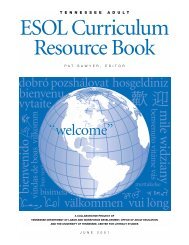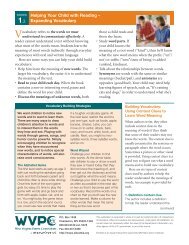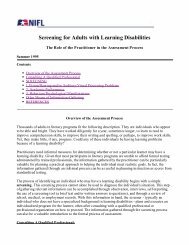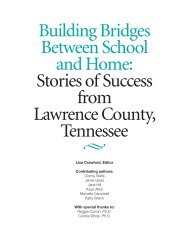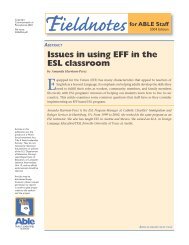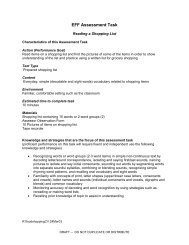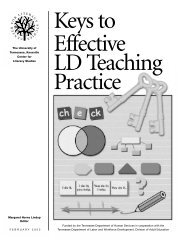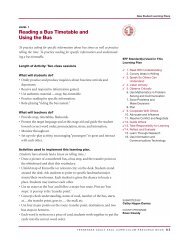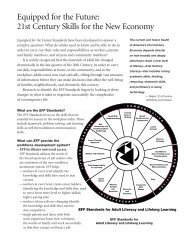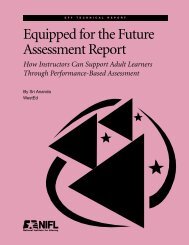Performance Continuum for Solve Problems and Make Decisions (pdf)
Performance Continuum for Solve Problems and Make Decisions (pdf)
Performance Continuum for Solve Problems and Make Decisions (pdf)
Create successful ePaper yourself
Turn your PDF publications into a flip-book with our unique Google optimized e-Paper software.
Equipped <strong>for</strong> the Future<br />
<strong>Solve</strong> <strong>Problems</strong> <strong>and</strong> <strong>Make</strong> <strong>Decisions</strong> <strong>Per<strong>for</strong>mance</strong> <strong>Continuum</strong><br />
PERFORMANCE LEVEL 1<br />
<strong>Solve</strong> <strong>Problems</strong> <strong>and</strong> <strong>Make</strong> <strong>Decisions</strong><br />
How adults at Level 1 <strong>Solve</strong> <strong>Problems</strong> <strong>and</strong> <strong>Make</strong> <strong>Decisions</strong>:<br />
• Anticipate or identify problems.<br />
• Use in<strong>for</strong>mation from diverse sources to arrive at a clearer underst<strong>and</strong>ing of the problem <strong>and</strong> its<br />
root causes.<br />
• Generate alternative solutions.<br />
• Evaluate strengths <strong>and</strong> weaknesses of alternatives, including potential risks <strong>and</strong> benefits <strong>and</strong><br />
short- <strong>and</strong> long-term consequences.<br />
• Select alternative that is most appropriate to goal, context <strong>and</strong> available resources.<br />
• Establish criteria <strong>for</strong> evaluating effectiveness of solution or decision.<br />
Level 1 Indicators<br />
Use Key Knowledge, Skills, <strong>and</strong> Strategies<br />
Adults per<strong>for</strong>ming at Level 1 can:<br />
• Anticipate or identify a problem or conflict, <strong>and</strong> gather relevant in<strong>for</strong>mation about the<br />
problem/conflict <strong>and</strong> its root causes from at least one familiar source, through use of simple<br />
strategies such as drawing on personal experience, asking questions, <strong>and</strong> reading/listening to<br />
input of others.<br />
• Demonstrate through talk, simple drawings or simple role-plays, a basic underst<strong>and</strong>ing of<br />
problem/conflict <strong>and</strong> its root causes by use of a few simple strategies such as recalling/restating<br />
key in<strong>for</strong>mation, <strong>and</strong> posing the problem as a question to be answered; <strong>and</strong> draw at least one<br />
logical causal link between the problem/conflict <strong>and</strong> its context.<br />
• Propose a limited number of solutions that require few sequenced steps <strong>and</strong> limited new<br />
in<strong>for</strong>mation or resources.<br />
• Evaluate the proposed solutions, <strong>and</strong> choose one based on its apparent causal connection to the<br />
problem <strong>and</strong> its appropriateness given context <strong>and</strong> available resources<br />
• Plan <strong>and</strong> carry out the selected solution process; use a few simple strategies to monitor progress<br />
toward a solution such as trial <strong>and</strong> error, further questioning <strong>and</strong> seeking suggestions; <strong>and</strong> adjust<br />
approach as necessary based on feedback.<br />
Show Fluency, Independence, <strong>and</strong> Ability to Per<strong>for</strong>m in a Range of Settings<br />
Adults per<strong>for</strong>ming at Level 1 can solve problems <strong>and</strong> make decisions, with noticeable ef<strong>for</strong>t <strong>and</strong><br />
hesitation, <strong>and</strong> supported by substantial outside help, guidance, suggestions <strong>and</strong> prompting, to accomplish<br />
very simple, well defined <strong>and</strong> highly structured tasks that require very simple but intentional solution<br />
strategies, in a few com<strong>for</strong>table <strong>and</strong> familiar settings<br />
Level 1 Examples of Proficient <strong>Per<strong>for</strong>mance</strong><br />
Adults per<strong>for</strong>ming at Level 1 can <strong>Solve</strong> <strong>Problems</strong> <strong>and</strong> <strong>Make</strong> <strong>Decisions</strong> to accomplish a variety of goals,<br />
such as:<br />
• Determine a list of parent education topics to be addressed by the local adult learning center in<br />
response to students’ concerns about their children’s behavior, health <strong>and</strong> safety<br />
• Address complaints from co-workers about untidy conditions in the employee break room<br />
1
Equipped <strong>for</strong> the Future<br />
<strong>Solve</strong> <strong>Problems</strong> <strong>and</strong> <strong>Make</strong> <strong>Decisions</strong> <strong>Per<strong>for</strong>mance</strong> <strong>Continuum</strong><br />
PERFORMANCE LEVEL 2<br />
<strong>Solve</strong> <strong>Problems</strong> <strong>and</strong> <strong>Make</strong> <strong>Decisions</strong><br />
How adults Level 2 <strong>Solve</strong> <strong>Problems</strong> <strong>and</strong> <strong>Make</strong> <strong>Decisions</strong>:<br />
• Anticipate or identify problems.<br />
• Use in<strong>for</strong>mation from diverse sources to arrive at a clearer underst<strong>and</strong>ing of the problem <strong>and</strong> its<br />
root causes.<br />
• Generate alternative solutions.<br />
• Evaluate strengths <strong>and</strong> weaknesses of alternatives, including potential risks <strong>and</strong> benefits <strong>and</strong><br />
short- <strong>and</strong> long-term consequences.<br />
• Select alternative that is most appropriate to goal, context <strong>and</strong> available resources.<br />
• Establish criteria <strong>for</strong> evaluating effectiveness of solution or decision.<br />
Level 2 Indicators<br />
Use Key Knowledge, Skills, <strong>and</strong> Strategies<br />
Adults per<strong>for</strong>ming at Level 2 can:<br />
• Anticipate or identify a problem or conflict, <strong>and</strong> gather <strong>and</strong> organize relevant in<strong>for</strong>mation about<br />
the problem/conflict <strong>and</strong> its root causes from more than one familiar source, through use of<br />
strategies such as simplification by constraining the problem into parts, considering the problem<br />
from a divergent point of view, basic research <strong>and</strong> comparison/contrast of data.<br />
• Demonstrate through talk, writing or drawing, a basic underst<strong>and</strong>ing of problem/conflict <strong>and</strong> its<br />
root causes by use of a range of simple strategies such as re<strong>for</strong>mulating the problem, summarizing<br />
<strong>and</strong> paraphrasing key in<strong>for</strong>mation, <strong>and</strong> drawing simple analogies; <strong>and</strong> draw appropriate causal<br />
links between the problem/conflict <strong>and</strong> its context.<br />
• Propose, <strong>and</strong>/or adapt from similar problem situations, multiple solutions that require sequenced<br />
steps <strong>and</strong> use of some additional in<strong>for</strong>mation or available resources.<br />
• Evaluate the proposed solutions, <strong>and</strong> choose one based on its apparent causal connection to the<br />
problem <strong>and</strong> its appropriateness given context <strong>and</strong> available resources<br />
• Plan <strong>and</strong> carry out the selected solution process; use a range of simple strategies to monitor<br />
progress toward a solution such as interim summary <strong>and</strong> evaluation of activities, solicitation of<br />
external “expert” review, <strong>and</strong> some prediction based on a recognition of patterns in behaviors or<br />
events; <strong>and</strong> adjust approach as necessary based on feedback.<br />
Show Fluency, Independence, <strong>and</strong> Ability to Per<strong>for</strong>m in a Range of Settings<br />
Adults per<strong>for</strong>ming at Level 2 can solve problems <strong>and</strong> make decisions, with some ef<strong>for</strong>t <strong>and</strong> hesitation, <strong>and</strong><br />
with some outside help, guidance, suggestions <strong>and</strong> prompting, <strong>and</strong> can sometimes lead others, to<br />
accomplish simple, fairly well-defined <strong>and</strong> structured tasks that require fairly simple but multi-step<br />
solution strategies, in a range of com<strong>for</strong>table <strong>and</strong> familiar settings<br />
Level 2 Examples of Proficient <strong>Per<strong>for</strong>mance</strong><br />
Adults per<strong>for</strong>ming at Level 2 can <strong>Solve</strong> <strong>Problems</strong> <strong>and</strong> <strong>Make</strong> <strong>Decisions</strong> to accomplish a variety of goals,<br />
such as:<br />
• Determine how to continue English language studies when current class has ended <strong>for</strong> summer<br />
break<br />
• Plan meals <strong>for</strong> a week that family members will like, on a limited grocery budget<br />
• Arrange <strong>for</strong> a reliable, on-time means of transportation to <strong>and</strong> from school or work<br />
• Pursue a plan <strong>for</strong> alleviating stress that is negatively affecting one’s health<br />
• Modify “ideal” vacation plans to fit within a limited budget<br />
• Find ways to minimize violation of class ground rules concerning attendance <strong>and</strong> lateness<br />
2
Equipped <strong>for</strong> the Future<br />
<strong>Solve</strong> <strong>Problems</strong> <strong>and</strong> <strong>Make</strong> <strong>Decisions</strong> <strong>Per<strong>for</strong>mance</strong> <strong>Continuum</strong><br />
PERFORMANCE LEVEL 3<br />
<strong>Solve</strong> <strong>Problems</strong> <strong>and</strong> <strong>Make</strong> <strong>Decisions</strong><br />
How adults at Level 1 <strong>Solve</strong> <strong>Problems</strong> <strong>and</strong> <strong>Make</strong> <strong>Decisions</strong>:<br />
• Anticipate or identify problems.<br />
• Use in<strong>for</strong>mation from diverse sources to arrive at a clearer underst<strong>and</strong>ing of the problem <strong>and</strong> its<br />
root causes.<br />
• Generate alternative solutions.<br />
• Evaluate strengths <strong>and</strong> weaknesses of alternatives, including potential risks <strong>and</strong> benefits <strong>and</strong><br />
short- <strong>and</strong> long-term consequences.<br />
• Select alternative that is most appropriate to goal, context <strong>and</strong> available resources.<br />
• Establish criteria <strong>for</strong> evaluating effectiveness of solution or decision.<br />
Level 3 Indicators<br />
Use Key Knowledge, Skills, <strong>and</strong> Strategies<br />
Adults per<strong>for</strong>ming at Level 3 can:<br />
• Anticipate or identify a problem or conflict, <strong>and</strong> gather <strong>and</strong> organize relevant in<strong>for</strong>mation about<br />
the problem/conflict <strong>and</strong> its root causes from multiple familiar <strong>and</strong> some unfamiliar sources,<br />
through use of a range of strategies such as research, studying analyses of similar problems,<br />
classification <strong>and</strong> categorization of resulting data, <strong>and</strong> drawing some inferences <strong>and</strong><br />
generalizations based on that data.<br />
• Demonstrate through a variety of representations such as speech, writing, graphics, simulations<br />
<strong>and</strong> computer modeling, an underst<strong>and</strong>ing of problem/conflict <strong>and</strong> its root causes by use of a<br />
range of strategies such as analyzing key in<strong>for</strong>mation, identifying predictable patterns in<br />
behaviors or events, <strong>and</strong> drawing extensive analogies; <strong>and</strong> integrate learning into a logical <strong>and</strong><br />
coherent position on the causal links between the problem/conflict <strong>and</strong> its context.<br />
• Propose multiple, innovative solutions that require complex sequenced steps <strong>and</strong> use of additional<br />
in<strong>for</strong>mation or available resources.<br />
• Evaluate the proposed solutions, <strong>and</strong> choose one based on its strong causal connection to the<br />
problem <strong>and</strong> its appropriateness given context <strong>and</strong> available resources<br />
• Plan <strong>and</strong> carry out the selected solution process; use a range of strategies to monitor progress<br />
toward a solution, such as active hypothesis testing <strong>and</strong> verification, <strong>and</strong> prediction <strong>and</strong> judgment<br />
based on testing/verification procedures as well as on a recognition of patterns in behaviors or<br />
events; <strong>and</strong> adjust approach as necessary based on feedback.<br />
Show Fluency, Independence, <strong>and</strong> Ability to Per<strong>for</strong>m in a Range of Settings<br />
Adults per<strong>for</strong>ming at Level 3 can solve problems <strong>and</strong> make decisions, consistently <strong>and</strong> with minimal<br />
ef<strong>for</strong>t, <strong>and</strong> with little need <strong>for</strong> guidance, help or prompting, <strong>and</strong> can lead <strong>and</strong> support others in problemsolving,<br />
to accomplish complex, minimally defined <strong>and</strong> structured tasks that require complex, multi-step<br />
solution strategies, in a range of com<strong>for</strong>table <strong>and</strong> familiar settings<br />
Level 3 Examples of Proficient <strong>Per<strong>for</strong>mance</strong><br />
Adults per<strong>for</strong>ming at Level 3 can <strong>Solve</strong> <strong>Problems</strong> <strong>and</strong> <strong>Make</strong> <strong>Decisions</strong> to accomplish a variety of goals,<br />
such as:<br />
• Select <strong>and</strong> vote <strong>for</strong> a political c<strong>and</strong>idate who you believe will most likely solve a problem you<br />
have identified in the community<br />
• Identify <strong>and</strong> change behaviors that are weakening one’s per<strong>for</strong>mance in job interviews<br />
• Address disruptive behavior by students in the local learning center<br />
• Select an in-home caregiver <strong>for</strong> an elderly family member who can no longer care <strong>for</strong> herself<br />
• Address credit problems that have resulted from lack of underst<strong>and</strong>ing of credit card rules <strong>and</strong><br />
regulations<br />
3
Equipped <strong>for</strong> the Future<br />
<strong>Solve</strong> <strong>Problems</strong> <strong>and</strong> <strong>Make</strong> <strong>Decisions</strong> <strong>Per<strong>for</strong>mance</strong> <strong>Continuum</strong><br />
How to Read the EFF <strong>Per<strong>for</strong>mance</strong> <strong>Continuum</strong> <strong>for</strong><br />
<strong>Solve</strong> <strong>Problems</strong> <strong>and</strong> <strong>Make</strong> <strong>Decisions</strong><br />
Each per<strong>for</strong>mance level of the EFF <strong>Per<strong>for</strong>mance</strong> <strong>Continuum</strong> <strong>for</strong> each EFF St<strong>and</strong>ard is divided<br />
into four sections:<br />
Section 1: The Definition of the St<strong>and</strong>ard<br />
Section 1 is the definition of the St<strong>and</strong>ard. The definition of the st<strong>and</strong>ard in the components of<br />
per<strong>for</strong>mance is a useful tool <strong>for</strong> communicating to adult learners <strong>and</strong> their teachers the essential<br />
features of the construct <strong>for</strong> each st<strong>and</strong>ard. By “unmasking the construct” in this way (making it<br />
clear how the skills of solving problems <strong>and</strong> making decisions are defined), adult learners are<br />
better able to articulate their own learning goals <strong>for</strong> improving proficiency <strong>and</strong> teachers are better<br />
able to focus learning <strong>and</strong> instructional activities that build toward the goal of increasing ability<br />
to <strong>Solve</strong> <strong>Problems</strong> <strong>and</strong> <strong>Make</strong> <strong>Decisions</strong> to accomplish everyday activities.<br />
The definition of the EFF St<strong>and</strong>ard <strong>Solve</strong> <strong>Problems</strong> <strong>and</strong> <strong>Make</strong> <strong>Decisions</strong> is repeated in the same<br />
<strong>for</strong>m at each level of the continuum. This repetition serves as a reminder that the integrated skill<br />
process defined by the components of per<strong>for</strong>mance <strong>for</strong> this st<strong>and</strong>ard is constant across all levels,<br />
from novice to expert levels of per<strong>for</strong>mance. Thus, the st<strong>and</strong>ard does not change from level to<br />
level. It remains a consistent focal point <strong>for</strong> learning <strong>and</strong> instruction. What changes from level<br />
to level is the growth <strong>and</strong> complexity of the underlying knowledge base <strong>and</strong> the resulting<br />
increases in fluency <strong>and</strong> independence in using the st<strong>and</strong>ard to accomplish an increasing range<br />
<strong>and</strong> variety of tasks. These changes are reflected in the descriptions of key knowledge, skills,<br />
<strong>and</strong> strategies at each level (Section 2); descriptions of fluent <strong>and</strong> independent per<strong>for</strong>mance in a<br />
range of settings at each level (Section 3); <strong>and</strong> the examples of real-world activities that can be<br />
accomplished at each level (Section 4).<br />
Section 2: Key Knowledge, Skills, <strong>and</strong> Strategies<br />
Section 2 of the per<strong>for</strong>mance continuum <strong>for</strong> <strong>Solve</strong> <strong>Problems</strong> <strong>and</strong> <strong>Make</strong> <strong>Decisions</strong> contains<br />
descriptions of some of the key knowledge, skills, <strong>and</strong> strategies that <strong>for</strong>m the basis <strong>for</strong> proficient<br />
per<strong>for</strong>mance on the st<strong>and</strong>ard at each level. This listing of key knowledge, skills, <strong>and</strong> strategies is<br />
specific to each level <strong>and</strong> is the foundation <strong>for</strong> designing assessments to measure per<strong>for</strong>mance at<br />
that level. Beyond serving as guide <strong>for</strong> assessment development, the key knowledge, skills, <strong>and</strong><br />
strategies described at each per<strong>for</strong>mance level can also be used to identify instructional<br />
objectives or can be included in the criteria used <strong>for</strong> placement of learners in instructional levels.<br />
Content Knowledge <strong>for</strong> Problem Identification <strong>and</strong> Representation<br />
The first bullet under Key Knowledge, Skills <strong>and</strong> Strategies related to ability to <strong>Solve</strong> <strong>Problems</strong><br />
<strong>and</strong> <strong>Make</strong> <strong>Decisions</strong> addresses behaviors that demonstrate ability to recognize a problem to be<br />
solved (whether it is already a problem or is likely to become one), <strong>and</strong> then to access whatever<br />
4
Equipped <strong>for</strong> the Future<br />
<strong>Solve</strong> <strong>Problems</strong> <strong>and</strong> <strong>Make</strong> <strong>Decisions</strong> <strong>Per<strong>for</strong>mance</strong> <strong>Continuum</strong><br />
in<strong>for</strong>mation is needed to underst<strong>and</strong> the nature of the problem, why the problem exists <strong>and</strong> what<br />
factors have contributed to it. While problem identification is constant at every level, at level 1<br />
the sources of in<strong>for</strong>mation available to increase underst<strong>and</strong>ing of the problem situation, <strong>and</strong> ways<br />
to access that in<strong>for</strong>mation, are limited <strong>and</strong> familiar to the problem solver (activating one’s own<br />
schema, remembering one’s own experience, asking others about their experience, possibly<br />
reading simply-written materials). While at this novice stage of problem solving the available<br />
in<strong>for</strong>mation is fairly concrete, it is nevertheless critical that the problem-solver be able to<br />
distinguish relevant from irrelevant in<strong>for</strong>mation about the situation in order to get a clear picture<br />
of root causes of the problem.<br />
Development along the <strong>Continuum</strong> of <strong>Per<strong>for</strong>mance</strong> is marked by ability to tap a greater number<br />
of increasingly complex <strong>and</strong> less familiar or easily-accessible sources of in<strong>for</strong>mation. The<br />
in<strong>for</strong>mation itself may be more abstract. There<strong>for</strong>e, development is also characterized by an<br />
evolving ability to organize relevant in<strong>for</strong>mation from these varied sources around key principles<br />
or themes in order to fully underst<strong>and</strong> the problem situation. The problem solver shows<br />
increasing ability to combine bits of relevant in<strong>for</strong>mation into a meaningful whole, a “bigger<br />
picture”, <strong>and</strong> to compare new in<strong>for</strong>mation with relevant, previously-acquired in<strong>for</strong>mation. By<br />
level 3, full underst<strong>and</strong>ing necessitates not only literal interpretation of, but also generalizations<br />
<strong>and</strong> inferences drawn from, coherently-organized data related to the problem to be solved.<br />
In order to solve a problem once identified, effective problem-solvers utilize their underst<strong>and</strong>ing<br />
of the problem situation to create mental models or internal representations of the problem in a<br />
<strong>for</strong>m that is “solvable”, i.e., that allows the problem solver to attend to the in<strong>for</strong>mation most<br />
immediately relevant <strong>and</strong> that suggests the best possible solution strategies. The second bullet<br />
under Key Knowledge, Skills <strong>and</strong> Strategies on the EFF <strong>Per<strong>for</strong>mance</strong> <strong>Continuum</strong> related to<br />
ability to <strong>Solve</strong> <strong>Problems</strong> <strong>and</strong> <strong>Make</strong> <strong>Decisions</strong> deals with representation of a problem; however,<br />
<strong>for</strong> the purposes of teaching <strong>and</strong> assessing problem-solving skills, representation here is not only<br />
a matter of internal meaning-making but also a mode of external communication of one’s<br />
internal meaning-making – one’s “mental model” of the problem. Development along the<br />
continuum is characterized by the number <strong>and</strong> sophistication of methods used to communicate<br />
underst<strong>and</strong>ing of the problem <strong>and</strong> its root causes, as well as by the quality <strong>and</strong> complexity of the<br />
causal connections drawn between the problem itself <strong>and</strong> other elements of the problem<br />
situation. At level 1, available representations are few, simple <strong>and</strong> concrete, focusing on fairly<br />
superficial features of a situation or individual statements/articulations of fact. At level 2 we see<br />
a growing repertoire of methods to represent the problem (increasing the likelihood of clear<br />
communication to others) <strong>and</strong> some movement beyond concrete treatment <strong>and</strong> toward integration<br />
of in<strong>for</strong>mation. By level 3 the problem solver uses a wide range of methods <strong>and</strong> is increasingly<br />
able to provide representations of problem situations that focus on underlying principles <strong>and</strong><br />
feature coherent organization of relevant in<strong>for</strong>mation around them<br />
Strategic Knowledge <strong>for</strong> Problem-Solving<br />
As indicated above, the soundness of a problem-solver’s representation of a problem situation<br />
will have a direct impact on the number <strong>and</strong> quality of strategies available to that person <strong>for</strong><br />
solving the problem. This strategic knowledge that follows from content underst<strong>and</strong>ing is the<br />
focus of the third <strong>and</strong> fourth bulleted categories under Knowledge, Skills <strong>and</strong> Strategies at each<br />
5
Equipped <strong>for</strong> the Future<br />
<strong>Solve</strong> <strong>Problems</strong> <strong>and</strong> <strong>Make</strong> <strong>Decisions</strong> <strong>Per<strong>for</strong>mance</strong> <strong>Continuum</strong><br />
level of <strong>Solve</strong> <strong>Problems</strong> <strong>and</strong> <strong>Make</strong> <strong>Decisions</strong>. We treat these bullets together, as they together<br />
address the ability to generate, evaluate, <strong>and</strong> select among alternative solution paths – the best<br />
strategies in the best combinations or sequences -- that are suggested by one’s problem<br />
representation.<br />
Development along the <strong>Per<strong>for</strong>mance</strong> <strong>Continuum</strong> with reference to generating alternate solutions<br />
to the problem is characterized by a growing number of solution strategies available to the<br />
problem-solver, but also by increasing sophistication of those strategies <strong>and</strong> complexity of the<br />
combination or sequence of those strategies necessary <strong>for</strong> a positive outcome. At level 1 the<br />
problem-solver can generate a small number of (but more than one) fairly simple options,<br />
utilizing a few primarily general strategies suggested primarily by existing problem-solving<br />
schema. At level 2 the problem-solver generates a larger number of alternatives to choose from,<br />
<strong>and</strong> as domain-specific content underst<strong>and</strong>ing is increasing at this level, the available strategies<br />
will include some that are domain-specific as well as general. Further, the potential solution<br />
paths, each featuring some combination of those strategies, are becoming slightly more complex.<br />
By level 3, rich content underst<strong>and</strong>ing <strong>and</strong> a coherent <strong>and</strong> principled representation of the<br />
problem situation allow the problem-solver to choose among a large store of both domainspecific<br />
<strong>and</strong> domain-independent strategies, <strong>and</strong> to combine them in innovative ways, in order to<br />
generate many alternative solutions to the problem.<br />
While the ability to generate alternative solution strategies is described developmentally along<br />
the <strong>Continuum</strong>, the act of evaluating <strong>and</strong> selecting among these strategies is treated as a constant<br />
at all levels. In every case, at each stage of development, the problem solver must be able to use<br />
the in<strong>for</strong>mation available in the problem representation as the basis <strong>for</strong> criteria to evaluate<br />
options <strong>for</strong> a solution. A further important point here is the recognition that there may no one<br />
externally-defined “correct” procedure <strong>for</strong> solving a given problem. In the case where a variety<br />
of solutions may be “correct”, it is important at every level of problem-solving that the particular<br />
problem context <strong>and</strong> resources available are taken into consideration as one evaluates <strong>and</strong><br />
chooses solution options.<br />
Meeting the Need to <strong>Solve</strong> <strong>Problems</strong> <strong>and</strong> <strong>Make</strong> <strong>Decisions</strong><br />
The final bullet under Knowledge, Skills <strong>and</strong> Strategies used at each level of <strong>Solve</strong> <strong>Problems</strong> <strong>and</strong><br />
<strong>Make</strong> <strong>Decisions</strong> addresses actual implementation of the selected solution strategy <strong>and</strong><br />
monitoring of its outcomes. Some aspects of the activity described here remain constant across<br />
all levels of the <strong>Per<strong>for</strong>mance</strong> <strong>Continuum</strong>. At each level, the problem-solver enacts the selected<br />
strategies in the decided-upon combinations – in other words, pursues the selected solution. And<br />
at each level the problem solver makes changes in that approach, or not, depending on whether<br />
the approach produces the desired outcome – in other words, whether or not the problem is then<br />
perceived to be solved. What changes from level to level, <strong>and</strong> what introduces the critical<br />
metacognitive aspects of problem-solving here, is the ability to monitor what happens while, <strong>and</strong><br />
after, one implements the selected solution strategy. Development from novice toward expertise<br />
in this area is marked by the number <strong>and</strong> complexity of ways that a problem-solver can seek <strong>and</strong><br />
secure useful feedback about how well the solution strategy is working toward the solution goal.<br />
At level 1 monitoring activities are intentional but few <strong>and</strong> simple, focusing primarily on<br />
discovering individual surface or obvious changes. However, by level 3 the number <strong>and</strong> range of<br />
6
Equipped <strong>for</strong> the Future<br />
<strong>Solve</strong> <strong>Problems</strong> <strong>and</strong> <strong>Make</strong> <strong>Decisions</strong> <strong>Per<strong>for</strong>mance</strong> <strong>Continuum</strong><br />
these activities have exp<strong>and</strong>ed to include many sophisticated, often technically complex<br />
procedures that allow the problem solver to see patterns of change, make predictions about future<br />
change, <strong>and</strong> draw conclusions based on sound data.<br />
Section 3: Fluency, Independence <strong>and</strong> Ability to Per<strong>for</strong>m in a Range of Settings<br />
Section 3 is the description of fluency, independence <strong>and</strong> ability to per<strong>for</strong>m in a range of settings<br />
expected <strong>for</strong> proficient per<strong>for</strong>mance on the st<strong>and</strong>ard at each level. Like the description of key<br />
knowledge, skills <strong>and</strong> strategies in Section 2, the descriptions in Section 3 are specific to each<br />
level <strong>and</strong> are intended to serve as a basis <strong>for</strong> guiding assessment, learning <strong>and</strong> instruction that is<br />
appropriate to that level.<br />
With regard to <strong>Solve</strong> <strong>Problems</strong> <strong>and</strong> <strong>Make</strong> <strong>Decisions</strong>, key features of this section are descriptions<br />
of the level of ef<strong>for</strong>t required to accomplish a problem-solving task (relative difficulty or ease<br />
with which one engages in the problem-solving process) <strong>and</strong> the amount <strong>and</strong> kinds of external<br />
support needed to plan <strong>and</strong> implement a solution process. At the novice level, individual<br />
per<strong>for</strong>mance is noticeably ef<strong>for</strong>tful; the problem-solver depends on direction <strong>and</strong> prompting from<br />
others within highly structured activities to be able to communicate an adequate model of the<br />
problem, select appropriate solution strategies, <strong>and</strong> monitor outcomes. In the movement toward<br />
expertise, individual per<strong>for</strong>mance depends less <strong>and</strong> less on external direction or structure; the<br />
problem solver engages in, <strong>and</strong> eventually can initiate the process, with increasing ease <strong>and</strong><br />
com<strong>for</strong>t. In a group setting this developing expertise may also be enacted in the individual’s<br />
willingness <strong>and</strong> ability to lead others through the problem-solving process.<br />
Section 4: Examples of Applications of the St<strong>and</strong>ard<br />
Section 4 of the per<strong>for</strong>mance level descriptions provides a short list of examples of the<br />
purposeful applications of the st<strong>and</strong>ard (activities) that can be accomplished by an adult who is<br />
proficient at each level. This list of examples is illustrative <strong>and</strong> not exhaustive. Like Sections 2<br />
<strong>and</strong> 3, the descriptions of activities in Section 4 are specific to each per<strong>for</strong>mance level. These<br />
examples of things that adults can accomplish in the real world at each level of per<strong>for</strong>mance on<br />
the continuum are useful to adult learners <strong>and</strong> to their teachers as ways of making concrete the<br />
purpose <strong>and</strong> need <strong>for</strong> attaining increasing proficiency in per<strong>for</strong>mance on the st<strong>and</strong>ard. By making<br />
it clear what can be accomplished at each level, the descriptions of activities in Section 3 also<br />
provide motivation <strong>for</strong> higher levels of learning. The listing of real-world accomplishments also<br />
provides guidance <strong>for</strong> selecting <strong>and</strong> designing the content <strong>for</strong> instructional materials <strong>and</strong><br />
assessments.<br />
Problem-solving tasks here are defined with reference to two related features:<br />
• The relative complexity of the problem to be solved, <strong>and</strong><br />
• The number <strong>and</strong> relative complexity of the potential solution paths.<br />
At level 1, learners are expected to solve problems <strong>and</strong> make decisions in the context of tasks<br />
where the problem situation is very simple <strong>and</strong> very easily defined. Once the problem is<br />
identified <strong>and</strong> represented in tasks at this level (<strong>for</strong> instance, “people are not washing their own<br />
coffee cups after using them in the employee break room”), learners are required to generate <strong>and</strong><br />
7
Equipped <strong>for</strong> the Future<br />
<strong>Solve</strong> <strong>Problems</strong> <strong>and</strong> <strong>Make</strong> <strong>Decisions</strong> <strong>Per<strong>for</strong>mance</strong> <strong>Continuum</strong><br />
evaluate few, but more than one, very simple alternative solutions (<strong>for</strong> instance, “put up a sign”,<br />
or “provide disposable cups”). In level 2 tasks the problem situations are still fairly simple <strong>and</strong><br />
defined (“I need to decide how to feed my family this week on what we have left in Food<br />
Stamps”), but require learners to generate alternative solutions featuring multiple steps <strong>and</strong>/or<br />
combinations of strategies (“find out how much total money we have to spend on food, find out<br />
prices of things, come up with a couple menu options”, etc.) Finally, by level 3 the tasks are<br />
characterized by complex, ill-defined <strong>and</strong> often novel problem situations (“My credit is terrible –<br />
I don’t know why <strong>and</strong> I don’t know how to fix it, but I have to!”). They require learners to<br />
generate multiple, complex <strong>and</strong> sometimes innovative solutions (“learn credit card rules <strong>and</strong><br />
regulations, learn why immediate problems have arisen, get credit counseling/help to contact<br />
companies <strong>and</strong> set up payment plans, get a second job or some other source of additional income,<br />
develop or adjust current budget”, etc.)<br />
8
Equipped <strong>for</strong> the Future<br />
<strong>Solve</strong> <strong>Problems</strong> <strong>and</strong> <strong>Make</strong> <strong>Decisions</strong> <strong>Per<strong>for</strong>mance</strong> <strong>Continuum</strong><br />
Background to the EFF <strong>Solve</strong> <strong>Problems</strong> <strong>and</strong> <strong>Make</strong> <strong>Decisions</strong> <strong>Per<strong>for</strong>mance</strong><br />
<strong>Continuum</strong><br />
The EFF st<strong>and</strong>ard <strong>Solve</strong> <strong>Problems</strong> <strong>and</strong> <strong>Make</strong> <strong>Decisions</strong>, one of the three interrelated <strong>and</strong><br />
sometimes overlapping EFF st<strong>and</strong>ards that are categorized as “Decision-Making Skills”,<br />
highlights one domain of adult knowledge <strong>and</strong> skills that is critical <strong>for</strong> adults to be able to draw<br />
from in order to carry out their responsibilities in their roles as family members, workers, <strong>and</strong><br />
citizens. Defined generally as the ability to identify a problem situation, ask appropriate<br />
questions, make logical predictions <strong>and</strong> come to in<strong>for</strong>med decisions, problem-solving is broadly<br />
acknowledged as an important “learning to learn” skill across many domains of content<br />
knowledge <strong>and</strong> activity. Problem-solving is often cited by employers <strong>and</strong> practitioners in<br />
work<strong>for</strong>ce development – along with other skills related to teamwork <strong>and</strong> leadership capacity –<br />
as a critical “behavioral skill” <strong>for</strong> successful <strong>and</strong> productive employees. And behavioral<br />
scientists <strong>and</strong> field workers point to the importance of people’s “general orientation”, or a<br />
positive “set” or attitude toward problem-solving, that allows them to define a process <strong>for</strong><br />
finding out what they want (“problem” being defined as an unmet want) <strong>and</strong> how to get what<br />
they want in the most effective way, within a variety of adult activities <strong>and</strong> relationships.<br />
While the ability to solve problems <strong>and</strong> make decisions is acknowledged as a desirable focus of<br />
adult learning <strong>and</strong> development, explicit treatment of problem-solving is rarely found in the<br />
traditional, academics-focused adult basic skills curriculum outside of mathematics (<strong>and</strong> even in<br />
that domain, within fairly narrow parameters). So teaching <strong>and</strong> assessing problem-solving in<br />
adult basic/literacy/ESOL education, <strong>and</strong> doing so as necessary in complex, real-world adult<br />
contexts, across several domains of adult activity, is a fairly new endeavor. That has made our<br />
job -- to develop a <strong>Per<strong>for</strong>mance</strong> <strong>Continuum</strong> <strong>for</strong> the st<strong>and</strong>ard that will support valid <strong>and</strong> reliable<br />
assessment of individual per<strong>for</strong>mance on the st<strong>and</strong>ard -- a challenging one, <strong>and</strong> our<br />
underst<strong>and</strong>ing of competent adult per<strong>for</strong>mance in solving problems <strong>and</strong> making decisions<br />
continues to evolve.<br />
The empirical basis <strong>for</strong> the three per<strong>for</strong>mance level descriptions <strong>for</strong> the <strong>Solve</strong> <strong>Problems</strong> <strong>and</strong><br />
<strong>Make</strong> <strong>Decisions</strong> <strong>Per<strong>for</strong>mance</strong> <strong>Continuum</strong> is data on adult learner per<strong>for</strong>mance collected by EFF<br />
field researchers who developed <strong>and</strong> piloted activities <strong>and</strong> per<strong>for</strong>mance tasks based on this EFF<br />
st<strong>and</strong>ard in their ABE, GED, <strong>and</strong> ESL classes. We are particularly grateful to the teachers <strong>and</strong><br />
learners who “tread new ground” with this st<strong>and</strong>ard in order to provide rich descriptions of<br />
learner per<strong>for</strong>mance of the st<strong>and</strong>ard in their instructional contexts. Our current data does not<br />
support definitions of per<strong>for</strong>mance levels below or above the three levels we have described. In<br />
the future, research to support the description of higher per<strong>for</strong>mance levels or of “pre-Level 1”<br />
per<strong>for</strong>mance levels <strong>for</strong> more beginning level learners may be developed.<br />
The EFF approach to defining per<strong>for</strong>mance levels <strong>for</strong> <strong>Solve</strong> <strong>Problems</strong> <strong>and</strong> <strong>Make</strong> <strong>Decisions</strong><br />
depends on a conception of problem-solving as a domain-independent, integrated skills process<br />
that requires significant domain-specific content underst<strong>and</strong>ing. Specifically this process calls <strong>for</strong><br />
• Ability to identify, fully underst<strong>and</strong>, <strong>and</strong> represent (internally <strong>and</strong> <strong>for</strong> others) a problem to<br />
be solved;<br />
• Ability to generate, evaluate <strong>and</strong> choose the best among solution options;<br />
9
Equipped <strong>for</strong> the Future<br />
<strong>Solve</strong> <strong>Problems</strong> <strong>and</strong> <strong>Make</strong> <strong>Decisions</strong> <strong>Per<strong>for</strong>mance</strong> <strong>Continuum</strong><br />
• ability to select <strong>and</strong> use appropriate strategies (whether general or domain specific), in<br />
appropriate sequence or combination, to solve the problem;<br />
• ability to plan, carry out <strong>and</strong> monitor the effectiveness of a process <strong>for</strong> using these<br />
strategies, <strong>and</strong> to flexibly adjust the approach if feedback warrants.<br />
In addition to analysis of EFF field research data, we conducted a review of available research<br />
regarding problem-solving. In the background resources we studied, we found broad agreement<br />
that the development of problem-solving proficiency is demonstrated through progressively more<br />
efficient, fluent, <strong>and</strong> independent per<strong>for</strong>mance in solving increasingly complex, novel <strong>and</strong> illdefined<br />
problems.<br />
The EFF approach to defining the st<strong>and</strong>ard <strong>Solve</strong> <strong>Problems</strong> <strong>and</strong> <strong>Make</strong> <strong>Decisions</strong> outlined above<br />
has been influenced by the then-groundbreaking work of the Secretary’s Commission on<br />
Achieving Necessary Skills (SCANS). In the report that summarizes that work (USDOL, 1991),<br />
problem-solving is defined as the ability<br />
• to recognize that a problem exists (i.e. there is a discrepancy between what is <strong>and</strong> what<br />
should or could be),<br />
• to identify possible reasons <strong>for</strong> the discrepancy,<br />
• to devise <strong>and</strong> implement a plan of action to resolve it,<br />
• to evaluate <strong>and</strong> monitor progress, <strong>and</strong><br />
• to refine the plan as indicated by findings<br />
Furthermore, EFF’s definition of the st<strong>and</strong>ard <strong>Solve</strong> <strong>Problems</strong> <strong>and</strong> <strong>Make</strong> <strong>Decisions</strong> as an<br />
integrated process of applying knowledge <strong>and</strong> using strategies in meaningful contexts owes<br />
much to cognitive science research on the nature of learning <strong>and</strong> the development of expertise.<br />
As early as 1984, Brans<strong>for</strong>d <strong>and</strong> Stein characterized the “IDEAL” problem solver as one who<br />
can<br />
I identify the problem;<br />
D define <strong>and</strong> represent the problem;<br />
E explore possible strategies;<br />
A act on the strategies; <strong>and</strong><br />
L look back <strong>and</strong> evaluate the effects of these activities.<br />
In a more detailed characterization (one that directly addresses the metacognitive processes of<br />
organizing in<strong>for</strong>mation around key concepts <strong>and</strong> adjusting solution strategies based on selfmonitoring<br />
– important aspects of the EFF definition) Baxter, Elder <strong>and</strong> Glaser (1996) describe<br />
the competent problem-solver as one who<br />
• Provides coherent explanations based on underlying principles (rather than describing<br />
superficial features or making single statements of fact);<br />
• Generates a plan <strong>for</strong> solution based on adequate representation of the problem situation<br />
<strong>and</strong> possible procedures <strong>and</strong> outcomes;<br />
• Implements solution strategies that reflect relevant goals/subgoals; <strong>and</strong><br />
• Monitors actions <strong>and</strong> flexibly adjusts approach based on per<strong>for</strong>mance feedback.<br />
From a similar perspective, Mayer <strong>and</strong> Wittrock (1996) have defined problem-solving as<br />
cognitive processing directed at achieving a goal when no solution method is obvious to the<br />
10
Equipped <strong>for</strong> the Future<br />
<strong>Solve</strong> <strong>Problems</strong> <strong>and</strong> <strong>Make</strong> <strong>Decisions</strong> <strong>Per<strong>for</strong>mance</strong> <strong>Continuum</strong><br />
problem solver. Such processing involves the subprocesses of representing, planning <strong>and</strong><br />
executing, particularly the acts of<br />
• Identifying the problem,<br />
• Forming an internal representation,<br />
• Encoding the representation,<br />
• Planning,<br />
• Selecting strategies, <strong>and</strong><br />
• Monitoring solutions.<br />
Based on this definition of the cognitive process of problem-solving, the Center <strong>for</strong> Research on<br />
Evaluation, St<strong>and</strong>ards <strong>and</strong> Student Testing (CRESST) at the University of Cali<strong>for</strong>nia in Los<br />
Angeles has developed an approach to the assessment of problem solving skills. The CRESST<br />
approach, as articulated by Harry O’Neill (1997), focuses on<br />
• Domain-specific knowledge (content underst<strong>and</strong>ing);<br />
• Problem-solving strategies: either<br />
domain specific (“troubleshooting”), or<br />
domain independent (multiple problem representations, analogies, metaphors);<br />
• metacognition (planning, self-monitoring); <strong>and</strong><br />
• motivation (ef<strong>for</strong>t, self-efficacy)<br />
In other words, according to O’Neill, to solve problems well requires knowing something (<strong>and</strong><br />
being able to search <strong>for</strong> in<strong>for</strong>mation to improve one’s underst<strong>and</strong>ing); using intellectual tricks<br />
(problem-solving strategies); planning; monitoring progress toward solving the problem; <strong>and</strong><br />
being motivated to find a solution.<br />
The following is a brief discussion of additional research that supports key elements of the EFF<br />
definition of <strong>Solve</strong> <strong>Problems</strong> <strong>and</strong> <strong>Make</strong> <strong>Decisions</strong>.<br />
The “content” of problem-solving: knowledge<br />
The summary of CRESST’s approach above suggests that domain-specific content underst<strong>and</strong>ing<br />
is a critical concern in effective problem solving. As pointed out by McDaniel <strong>and</strong> Schlager<br />
(1990), herein lies a challenging aspect of teaching <strong>and</strong> assessing “general” or “domainindependent”<br />
problem-solving skills: the knowledge <strong>and</strong> skills required <strong>for</strong> effective problemsolving<br />
appear to differ across problem types (<strong>for</strong> instance, underst<strong>and</strong>ing the relationships<br />
among problem elements vs. knowing specific facts, data trends, principles, language, symbols,<br />
etc). Moreover, researchers seem to agree that most real-world problems require rich domainspecific<br />
knowledge – as O’Neill puts it, “You have to know something”.<br />
In the approach to problem-solving illustrated on the <strong>Per<strong>for</strong>mance</strong> <strong>Continuum</strong> <strong>for</strong> the EFF<br />
st<strong>and</strong>ard <strong>Solve</strong> <strong>Problems</strong> <strong>and</strong> <strong>Make</strong> <strong>Decisions</strong>, domain-specific knowledge includes<br />
underst<strong>and</strong>ing of the body of facts <strong>and</strong> procedures available to be brought to bear to a problem<br />
situation along with relevant in<strong>for</strong>mation from belief systems <strong>and</strong> “mental models”. It also<br />
encompasses key concepts around which to organize such in<strong>for</strong>mation, <strong>and</strong> the relationships<br />
11
Equipped <strong>for</strong> the Future<br />
<strong>Solve</strong> <strong>Problems</strong> <strong>and</strong> <strong>Make</strong> <strong>Decisions</strong> <strong>Per<strong>for</strong>mance</strong> <strong>Continuum</strong><br />
between those concepts. This domain-specific knowledge is built on previously acquired<br />
in<strong>for</strong>mation (prior knowledge) <strong>and</strong> the “intelligent use” of new in<strong>for</strong>mation.<br />
One important function of prior knowledge in the activation of domain-specific content<br />
underst<strong>and</strong>ing is what Nitko (2004) calls “schema-driven problem solving”. Our schemas, the<br />
distillations of previously acquired knowledge <strong>and</strong> experiences, help us to recognize familiar<br />
things about a situation, what we can expect to happen, <strong>and</strong> how we typically act in such a<br />
situation. If we recognize a problem as part of or very similar to one of our existing schema, we<br />
can apply a solution strategy stored in that schema. Schema are effectively activated when we<br />
can make an accurate mental representation, or “mental model” of the problem. Conversely, if<br />
<strong>for</strong> some reason we misrepresent the problem we may trigger the wrong schema <strong>and</strong> implement<br />
strategies that don’t work. In that case we need to reconceptualize the problem – change our<br />
mental representation – in order to draw from the appropriate body of prior knowledge to find<br />
appropriate solution strategies.<br />
Successful problem-solvers can also acquire <strong>and</strong> integrate new domain-specific knowledge when<br />
their current schemas do not provide them with sufficient resources to address the problem<br />
situation. Sternberg (1986) discusses three related cognitive processes that indicate effective<br />
integration of new in<strong>for</strong>mation in problem-solving activity; in this view, problem-solvers<br />
1. selectively encode in<strong>for</strong>mation (that is, identify, from the host of in<strong>for</strong>mation<br />
available, which in<strong>for</strong>mation is relevant to the problem at h<strong>and</strong>, <strong>and</strong> attend to it);<br />
2. selectively combine the relevant in<strong>for</strong>mation into a meaningful whole, in which<br />
associations between relevant pieces of in<strong>for</strong>mation are understood (if possible using<br />
the single optimal way <strong>for</strong> generating a solution to a particular problem); <strong>and</strong><br />
3. selectively compare the new in<strong>for</strong>mation with relevant, previously acquired<br />
in<strong>for</strong>mation<br />
This is what Mayer et al. would later call “intelligent use of in<strong>for</strong>mation” in problem-solving as<br />
they articulated the SCANS In<strong>for</strong>mation Competency – an integration process that involves the<br />
ability to identify relevant in<strong>for</strong>mation, distinguish it from irrelevant in<strong>for</strong>mation, <strong>and</strong> then<br />
integrate the relevant in<strong>for</strong>mation to solve problems. And the EFF st<strong>and</strong>ard addresses these<br />
cognitive processes that are involved in acquiring, interpreting, evaluating <strong>and</strong> communicating<br />
domain-specific in<strong>for</strong>mation necessary to solve a problem<br />
The “content” of problem-solving: solution strategies<br />
If the need <strong>for</strong> rich domain-specific content underst<strong>and</strong>ing poses a challenge <strong>for</strong> the teaching <strong>and</strong><br />
assessing of problem-solving skills, the nature of the solution strategies employed by effective<br />
problem-solvers raises even more interesting issues. Researchers <strong>and</strong> practitioners appear to be<br />
engaged in an ongoing controversy concerning whether adults should be taught problem-solving<br />
strategies that are general – that is, “domain-independent” -- or strategies that are specific to a<br />
content/curriculum area. It seems clear that domain –specific strategies are less applicable across<br />
domains but more powerful within the domain. And according to Nitko (2004), it appears that<br />
problem-solvers tend to use both kinds of strategies under different conditions; when people are<br />
unfamiliar with a content area they use general strategies, but as they develop expertise in<br />
domain-specific content underst<strong>and</strong>ing they increasingly use content area-specific strategies.<br />
12
Equipped <strong>for</strong> the Future<br />
<strong>Solve</strong> <strong>Problems</strong> <strong>and</strong> <strong>Make</strong> <strong>Decisions</strong> <strong>Per<strong>for</strong>mance</strong> <strong>Continuum</strong><br />
Ultimately, knowledge-based problem-solving methods within a particular domain provide much<br />
better solution strategies than more general methods; we need only think about “troubleshooting”<br />
a technical problem as an illustration. Nevertheless educators, work<strong>for</strong>ce development<br />
specialists, social service providers <strong>and</strong> others working with adults continue to stress the<br />
development of general problem-solving skills to be applied across the multiple domains of<br />
learning <strong>and</strong> activity that are the focus of their ef<strong>for</strong>ts. The EFF approach to this dilemma has<br />
taken 2 close paths. On the one h<strong>and</strong>, the 16 EFF st<strong>and</strong>ards include some in which problemsolving<br />
strategies are tied to a particular knowledge domain (Use Math to <strong>Solve</strong> <strong>Problems</strong> <strong>and</strong><br />
Communicate). In the case of the EFF st<strong>and</strong>ard <strong>Solve</strong> <strong>Problems</strong> <strong>and</strong> <strong>Make</strong> <strong>Decisions</strong>, however,<br />
an integrated domain-independent problem-solving process is defined, <strong>and</strong> growing expertise is<br />
marked on the <strong>Per<strong>for</strong>mance</strong> <strong>Continuum</strong> <strong>for</strong> the st<strong>and</strong>ard by increasing range <strong>and</strong> sophistication<br />
of both general <strong>and</strong> domain-specific problem-solving strategies available to be applied to a<br />
particular problem situation. This approach brings us back again to the importance of domainspecific<br />
content underst<strong>and</strong>ing in the EFF st<strong>and</strong>ard definition <strong>and</strong> <strong>Per<strong>for</strong>mance</strong> <strong>Continuum</strong>, as<br />
developing knowledge within a domain will suggest an increasing array of domain-specific<br />
solution strategies to choose from. Content knowledge <strong>and</strong> strategic knowledge, then, are<br />
integrally related in the development of problem-solving expertise.<br />
13
Equipped <strong>for</strong> the Future<br />
<strong>Solve</strong> <strong>Problems</strong> <strong>and</strong> <strong>Make</strong> <strong>Decisions</strong> <strong>Per<strong>for</strong>mance</strong> <strong>Continuum</strong><br />
Research Bibliography<br />
Brans<strong>for</strong>d, J. <strong>and</strong> Stein, B. (1984) The Ideal Problem <strong>Solve</strong>r: A Guide <strong>for</strong> Improving<br />
Thinking, Learning <strong>and</strong> Creativity. W.H. Freeman <strong>and</strong> Co.<br />
Bedell, J. <strong>and</strong> Lennox, S. (1997) H<strong>and</strong>book <strong>for</strong> Communication <strong>and</strong> Problem-Solving Skills<br />
Training: A Cognitive-Behavioral Approach. John Wiley <strong>and</strong> Sons, New York.<br />
McDaniel, M. <strong>and</strong> Schlager, M. (1990) “Discovery Learning <strong>and</strong> Transfer of Problem-<br />
Solving Skills”. Cognition <strong>and</strong> Instruction. Lawrence Erlbaum Associates, Mahwah, NJ<br />
Nitko, A.J. (2004) Educational Assessment of Students. Prentice-Hall, Pearson, Columbus,<br />
OH<br />
Occupational In<strong>for</strong>mation Network (O*Net) Consortium (2003). O*Net Online: Skills<br />
Search<br />
O’Neil, H. (1999). A Theoretical Basis <strong>for</strong> Assessment of Problem-Solving. Presentation at<br />
the Annual Meeting of the American Educational Research Association, Montreal, Canada<br />
O’Neil, H., Allred, K. <strong>and</strong> Baker, E. (1997). “Design of Teacher-Scored Measures <strong>for</strong><br />
Work<strong>for</strong>ce Readiness Competencies”. Work<strong>for</strong>ce Readiness: Competencies <strong>and</strong> Assessment.<br />
Lawrence Erlbaum Associates, Mahwah, NJ<br />
O’Neil, H. <strong>and</strong> Schacter, J. (1997). Test Specifications <strong>for</strong> Problem-Solving Assessment.<br />
Center <strong>for</strong> the Study of Evaluation, National Center <strong>for</strong> Research on Evaluation, St<strong>and</strong>ards<br />
<strong>and</strong> Student Testing (CRESST), University of Cali<strong>for</strong>nia at Los Angeles<br />
Qualifications Curriculum <strong>and</strong> Assessment Authority <strong>for</strong> Wales (2003). The Common<br />
Requirements Across the National Curriculum: Problem-Solving Skills<br />
Sternberg, R. (1986) Thinking <strong>and</strong> Problem Solving (H<strong>and</strong>book of Perception <strong>and</strong><br />
Cognition). Academic Press<br />
U.S. Department of Labor (1991). Report of the Secretary’s Commission on Achieving<br />
Necessary Skills (SCANS)<br />
14



